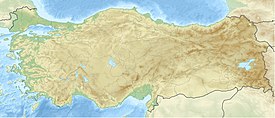Blaundus
 The ruins at Baundos, Turkey | |
| Location | Ulubey, Uşak Province, Turkey |
|---|---|
| Region | Lydia, Phrygia |
| Coordinates | 38°21′25″N 29°12′32″E / 38.35694°N 29.20889°E |
| Type | Ancient Greek settlement |
| History | |
| Builder | Lydian and Phrygian Greeks |
| Founded | 3rd century BC - 4th century BC |
| Abandoned | 12th century |
Blaundus (Ancient Greek: Βλαῦνδος) was a Greek city founded during the Hellenistic period[1][2] in Asia Minor, presently Anatolia (Asian Turkey), and is now a Latin Catholic titular bishopric.
History
[edit]The ancient city was between the regions of Lydia and Phrygia in the Seleucid Empire. Its ruins are in Sülümenli (formerly Süleimanli), near Ulubey (formerly Göbek) in the Uşak Province of modern Turkey.
Greek coins have been discovered which write the city name as Mlaundus.[3] A Greek inscription of the Roman period though write the city as Blaundus.[3]
Recent findings of cylinder-seals in archaeological excavation point towards the conclusion that there was a settlement already stablished at the beginning of the 2nd millennium BC, belonging to the Assyrian trade colony period.[4]
Bishopric
[edit]In the Roman and Byzantine eras, the city was the seat of a bishopric, a suffragan of the Metropolitan Archdiocese of Sardes. The diocese was known by the names Blaundus, Blandus and Balandus. It was part of the Patriarchate of Constantinople.[5][6][7] In the 5th century AD, the bishopric was connected to the diocese center at Sebaste.[8]
Three bishops of Blaundus are historically attested.[9][10]
- Phoebus (fl. 359), who at the Council of Seleucia in 359 distanced himself from his fellow Arians, signing the orthodox formula drafted by Acacius of Caesarea, and for this reason was deposed.
- Elijah or Helias (fl. 451) who took part in the Council of Chalcedon of 451.[11]
- Onesiphorus (fl. 458), who signed a letter written by the bishops of Lydia to Emperor Leo in 458 following the killing of Proterius of Alexandria.
Additionally, a certain Eustathius of Alandos attended the Council of Constantinople (879-880) that rehabilitated Photius, but evidence is lacking that Alandos was the same as Balandus.
The last record of Blaundus dates from the 12th century.
References
[edit]- ^ Cohen, Getzel M. (1978). The Seleucid Colonies: Studies in Founding, Administration and Organization. Franz Steiner Verlag. p. 16. ISBN 9783515025812.
- ^ Leake, William Martin (1854). Numismata Hellenica: A Catalogue of Greek Coins. Franz Steiner Verlag. p. 87.
- ^ a b Dictionary of Greek and Roman Geography (1854), Blaundus
- ^ Altuntaş, Leman (2022-09-29). "4,000-year-old cylinder seal found in Blaundos excavations". Arkeonews. Retrieved 2022-09-30.
- ^ Pius Bonifacius Gams, Series episcoporum Ecclesiae Catholicae, Leipzig 1931, p.447.
- ^ Quien (O.P.), Michel Le (1740). Oriens christianus: in quatuor patriarchatus digestus : quo exhibentur ecclesiae, patriarchae caeterique praesules totius orientis (in Latin). ex Typographia Regia.
- ^ Raymond Janin, v. Balandus, in Dictionnaire d'Histoire et de Géographie ecclésiastiques, vol. VI, 1932, coll. 306-307
- ^ "KURTARMA KAZILARI SEMINERI" (PDF). 8–10 April 1996. Archived from the original (PDF) on 22 Dec 2015.[page needed]
- ^ La sede titolare nel sito di www.catholic-hierarchy.org.
- ^ La sede titolare nel sito di www.gcatholic.org
- ^ Richard Price, Michael Gaddis, The Acts of the Council of Chalcedon, Volume 1 p90.


